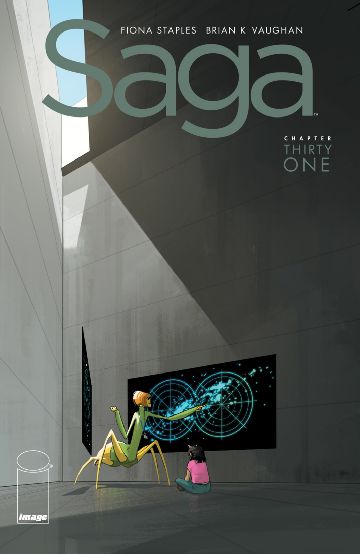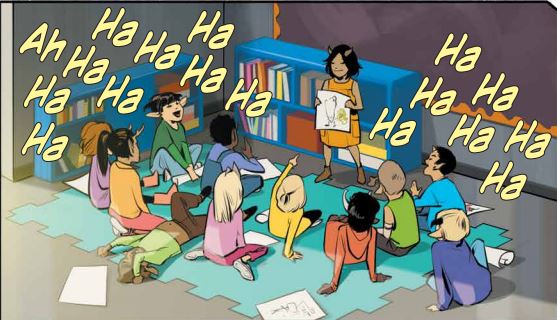Saga #31
Story by Brian K. Vaughan
Art by Fiona Staples
Letters by Fonografiks
Published by Image Comics
WARNING: SPOILERS AHEAD
After what seems like an eternity, Saga returns with an all-new story line. Last time, superstar couple Alana and Marko were separated from their daughter Hazel and her grandmother, Klara. Years later, Klara and Hazel are living in a Landfallian prison, keeping Hazel’s true identity a secret from the guards. What awaits Hazel and Klara? How long can they keep Hazel’s identity a secret? Will they be reunited with Marko and Alana? Action, secrecy, and drama makes the newest issue of Image Comics’ smash-hit series a fantastic read.
Fiona Staples continues to be a master artist, so much so that she gets first billing on the cover because, holy cow, does she deserve it! Speaking of covers, this new one is an improvement to the series. In the past 30 issues of Saga, characters and/or objects were placed in the foreground with a single, blank color palette in the background. Now, the covers include actual environments rich in detail. The interior art is just as eye-catching with fantastically designed yet realistic-looking characters, detailed scenery, and special effects that give big budget blockbusters a run for their money. The coloring is bright and vibrant like pop art; colors never mix and often highlight different parts of a character’s body and the clothes they wear. The result is a life-like quality that makes characters feel alive and animated, not just stiff illustrations. The lettering by Fonografiks is its own kind of art. Instead of the ALL CAPS style regular to mainstream comics, letters are structured like lines of prose, only the first letter of the beginning word of every new sentence and proper nouns capitalized. The lettering of Hazel’s narration (done by Staples) is loose and curvy like a journal entry. This makes both dialogue and narration more personal and human, a great counterbalance to the weird Scifi elements. All these various components make beautiful art that is both realistic and fantastical at the same time. At this point, Fiona could draw a crocodile chicken pooping, and it would still look great.
Brian K. Vaughan’s writing remains top-notch, combining Scifi, action, and drama. Saga #31 takes place a few years later after the events of the last arc and is meant to be a starting point for both new and long-time readers. As such, events leading to Hazel and Klara’s imprisonment are summarized instead of shown. A common criticism from detractors is that Vaughan incessantly protects the protagonists, even using deus ex machinas to keep them alive. Only getting a summary of how Hazel and Klara avoided death makes it seem too far-fetched. For those with a more flexible suspension of disbelief, the summary can be seen as a missed opportunity of storytelling. It would be cool to see Klara outsmart bad guys and maybe gain more insight into the politics of the never-ending war between Wreath and Landfall. However, readers familiar with Saga know that Vaughan is more interested in key moments of the protagonists’ lives, those that define and shape who they are. It’s the personal stories rather than the actual conflict that is the focus of the series. For some, this will be unsatisfactory, but for others, especially fans, it separates Saga from the now ubiquitous catalog of Scifi comics.
The true strength of the newest issue is the focus on Hazel. Despite her young age, she is a fully formed character. For example, her classmates in the prison school give presentations on things that make them sad. Mostly, they draw depressing scenes of dead family members and lost limbs as a result of war. Hazel’s turn comes, and she instead shows an illustration of a farting foot that makes everyone laugh. Already, Hazel is aware enough of people’s suffering to help them. The scene connects to the older Hazel who has insights to war and family, and shows how her formative years shaped her sociopolitical awareness.
Unfortunately, there is a dark side to awareness. In a flashback scene showing the moment after she is separated from her parents, Hazel witnesses Klara decapitate a man and has no response to it. Older Hazel says “nothing makes a kid grow up faster than wartime”, which indicates desensitization to violence. This raises questions, like what if Hazel sees war as an inevitability? Is her fart joke in class just a temporary relief for the children or part of a long term therapy to help them overcome their trauma? It will be interesting to see if Hazel’s formative years shape her to become an activist or merely an aware cynic.
What will probably resonant most with readers, especially LGBT+ readers, is the new character Petrichor. Saga is well-known for its positive representations of LGBT characters, and has now included a trans woman. She is introduced nude, but in an affirming, non-exploitative manner. She tells Hazel how the other women prisoners see her as a freak. Hazel, on the other hand, develops an understanding of Petrichor’s identity and even believes that if the guards can accept her, then the schoolteacher, Noreen, will accept Hazel. The parallel between Petrichor and Hazel is strong since both are considered freaks and seek affirmation of their bodies and, to a larger extent, their identities. Hopefully, Petrichor will play a bigger role in the story and become a fan favorite character.
Saga #31 continues to prove the series reputation as one of the best ongoing series currently published. Gorgeous art, serious drama, and positive LGBT representation are all found in a masterfully crafted package. Also, fan-favorite character Izabel returns after a long absence. YAY!
Big things are on the horizon and it’s the perfect time for readers, both old and new, to jump aboard.






